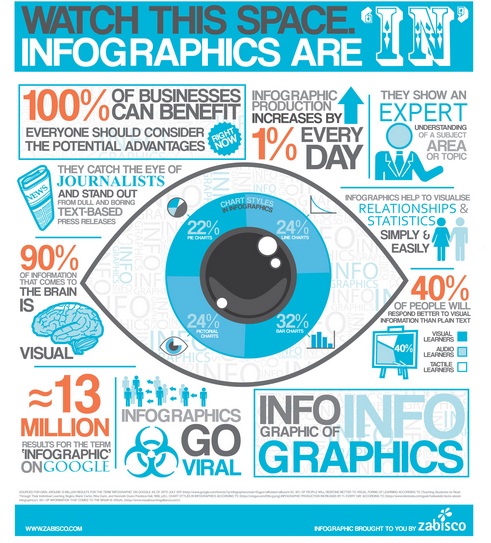Before getting into how to measure the value of infographics, let’s first look at what they are and what their purposes are in terms of content marketing. What goals can infographics meet for your overall content marketing objectives? Why should your business invest in producing and promoting an infographic? What should it say?
An Infographic Defined
An infographic is a fun, visually engaging way to communicate a lot of content that does not require a lot of reading. It’s a way to

get complex messaging in front of your target audience in a quick and stimulating way. You can already see the benefit, right? But there’s more…
The Spread: Infographic Marketing Across Multiple Industry Sectors
Infographics offer a quick way to cater content to various segmented audiences. If you are in need of this type of online marketing, infographics can be your best friend. Here are some ideas for infographic approaches and the audiences they could cater to. Keep in mind each type/approach has endless
audiences. These are merely examples:
Approach: Educational
Audience: Financial advice seekers
Content: Tools, guides, how to’s, budgeting advice, money savings scenarios, Webinar information, top finance blogs
Approach: Informative
Audience: Retail and/or service industry consumers
Content: Shopping trends, industry specific consumerism, advice on tipping, service trends in food & beverage or spa services, calorie information, top retail blogs, top food blogs
Approach: Interesting/Fun
Audience: Vacationers
Content: Hottest travel spots, travel maps, travel guides, how to pack lightly for kids, hiking ho-to’s, family vacation spots, dream vacation spots for romance, top destination blogs
Approach: Professional
Audience: Home buyers
Content: Real estate pricing by geographical area, mortgage trends, real estate statistics, home builder comparison, top real estate and mortgage blogs
You get the idea. Keep in mind that all of these examples can be drilled down to an even sharper focus on your target audience. For example, shopping trends could be women’s shoe shopping trends. You can even keep going. It could be the trend on women’s wedge shoes, starting from the 70s until now.
Determine your very specific audience and provide what they need or want to know. What information will be valuable for them to have and how can it be presented in an engaging way? One worthy suggestion (included in my examples above) is to always find a way to mention top blogs applicable to your target audience. It will give more value and authority to your message as well as to assist in validating the infographic itself.
Now that you know what infographics are and the types of approaches there are in creating them, you need to know what they are not:
Infographics Are Not Promotional!
Refer back to my definition at the beginning of this post. Infographics are informative. They are not promotional. Don’t miss that. Do not push your own brand or products. Your credit will be in the byline. Take credit as the resource for telling the story; but stay out of the story itself. See my blog post titled Don’t Photo Bomb Your Own Content Marketing for more on this.
Optimization and Share Capabilities
It won’t do much good to have a fantastic infographic if you don’t properly optimize it and set up user-friendly share capabilities. A typical byline credit states “Provided by {insert your brand}.” It should also have embedded code that links to one of your specific, relevant Web pages or your blog and an embedded code for sharing capabilities. You should host your infographic in its own blog post and definitely have easy share options available on the post itself.
You also need to spend time in promoting the infographic. You can take data points from the infographic to create multiple tweets and Facebook and Google+ posts. Pin it on Pinterest. Share it on LinkedIn. Submit it to niche resource sites, offer it to industry bloggers to share with their audiences and offer it to industry influencers in the social media space. Include a link to it on your email signature, add it in as part of your newsletter and include it in proposals, etc. The possibilities for promotion and exposure of your infographic are endless.
Some great examples of well-produced, well-targeted, well-optimized infographics can be found through the following link. Note how well these are placed and the great introduction that leads the audience in. Also heed the wrap-up that includes a clear call-to-action (defining at least one purpose/goal of the infographics): Best Infographic Examples
There are many ways to gain exposure for your infographic and ensure you get sound VOI and your efforts are fruitful. However, before you can determine how to measure VOI, you must first know what to measure.
Measuring VOI with Tangibles and Intangibles
Content marketing goals need to be tied directly to business goals. What are you trying to achieve with your infographic? More traffic to your blog? More traffic to a product or service page on your Website? Increased brand exposure as an industry resource? You first need to figure out your primary objective.
Second, you will need to consider production costs. How much will it cost to have the infographic developed, housed, optimized and promoted? When considering these things, know that it is important to consider both tangible AND intangible metrics in order to determine success.
Measuring VOI, or ROI for any content marketing effort, completely from a fiscal perspective is too limiting. Reality is not every online marketing and communication effort that adds value to your business can be directly tied to your revenue. For example, you cannot 100% measure the ROI of certain offline marketing efforts, such as hosting a booth and speaking at a conference or trade show. Or sponsoring a non-profit organization or fundraiser. Prospects may see your brand and never engage with you there, but look you up later and contact you. You may never know where they initially became exposed to your brand. That’s an intangible measurement. We all know there are multiple ROI factors that come in to play with these offline, in-person efforts. That’s why we do them. It’s the same with infographics. You have to measure both tangible and intangible efforts.
Collectively you must first determine your goals, then how to achieve them. That will determine how and what to measure, keeping in mind you need to consider all metrics (tangible and intangible).
If you need more information or assistance, contact us today: Infographic Development & Promotion




